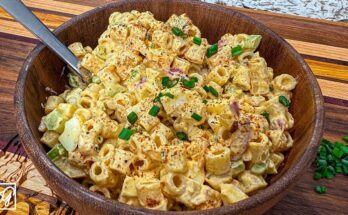Dijon Mustard Recipe: There’s something incredibly satisfying about making your own condiments, especially when it comes to the zesty, tangy punch of Dijon mustard.
While you could easily grab a jar off the shelf, homemade Dijon brings a depth of flavor you just can’t buy. It’s sharp, bold, and endlessly versatile—perfect for everything from sandwiches to salad dressings.
Ready to level up your kitchen game? Here’s your easy-to-follow, step-by-step guide to making Dijon mustard at home.
What is Dijon Mustard?
Dijon mustard is a classic French mustard that originated in the city of Dijon in Burgundy, France. Unlike yellow mustard, which is milder and sweeter, Dijon packs a punch with its sharp, intense flavor. It’s traditionally made with brown or black mustard seeds and white wine or wine vinegar, giving it a distinctive taste that’s savory and slightly spicy. Its creamy texture and robust flavor make it a kitchen staple in recipes worldwide.
Why Make It at Home?
Why go homemade when you can just buy it? Simple: flavor and freshness. Store-bought versions often contain preservatives, sugar, or fillers that dull the taste. Making Dijon at home not only gives you control over what goes into your mustard, but you can also tweak the flavors to match your taste buds perfectly. Plus, it’s surprisingly easy—and super satisfying—to whip up your own batch.
Ingredients You’ll Need
Essential Ingredients
Let’s talk about what goes into traditional Dijon mustard. Here’s your core lineup:
- Brown mustard seeds – These bring the bold, spicy kick Dijon is known for.
- Dry white wine – Adds acidity and depth (try Sauvignon Blanc or Chardonnay).
- White wine vinegar – Gives that sharp, tangy bite.
- Salt – Just a pinch to enhance the flavors.
- Garlic (optional) – Adds a mellow complexity if you want to mix it up.
- Water – For soaking the seeds and adjusting the texture.
Optional Add-Ins for Flavor
Want to play with flavor? Try these:
- Honey – For a touch of sweetness.
- Tarragon – A classic French herb that pairs beautifully with mustard.
- Shallots – Finely minced for a hint of onion flavor.
- Turmeric – For color and earthy depth.
The best part about homemade mustard? It’s totally customizable.
Tools Required for Homemade Dijon Mustard
Must-Have Kitchen Tools
You don’t need a full kitchen arsenal, just a few basics:
- Blender or food processor – To grind the mustard seeds into a smooth or coarse paste.
- Non-reactive bowl – Glass or ceramic works best for soaking the seeds.
- Small saucepan – For heating and simmering your mixture.
- Mason jars or airtight containers – For storage.
Handy Extras That Help
These aren’t necessary, but they’ll make things easier:
- Fine mesh strainer – If you want a super smooth texture.
- Digital scale – For more accurate ingredient measurements.
- Rubber spatula – Helps scrape every last bit of mustard from the blender.
Step-by-Step Dijon Mustard Recipe
Step 1: Soaking the Mustard Seeds
Start by soaking your mustard seeds in a mixture of white wine and vinegar. This softens the seeds and infuses them with tangy flavor. Here’s how:
- Combine ½ cup brown mustard seeds, ¾ cup dry white wine, and ½ cup white wine vinegar in a non-reactive bowl.
- Let them soak at room temperature for at least 12 hours—overnight works best.
During this time, the seeds will absorb the liquid and swell, becoming easier to blend later. Don’t rush this step; it’s the key to that signature Dijon smoothness.
Step 2: Blending the Seeds
After soaking, pour the mixture into a blender or food processor. Add 1 teaspoon of salt and 1 minced garlic clove (if using). Blend until the mixture reaches your desired consistency. Want it silky smooth? Blend longer. Prefer it with a bit of grainy bite? Pulse just a few times.
Taste and adjust. If it’s too thick, add a splash of water. Too pungent? A small spoonful of honey can mellow it out without overpowering the flavor.
Step 3: Cooking the Mustard Mixture
Transfer the blended mustard into a small saucepan. Heat it over medium-low heat, stirring constantly. This cooking step removes some of the bitterness and helps develop a richer, more balanced taste.
Let it simmer gently for about 10–15 minutes. Be sure to keep stirring and don’t let it boil—it can scorch quickly and turn bitter. The mustard will thicken slightly as it cooks.
Step 4: Cooling and Storing
Once the mustard is cooked, let it cool completely. Then spoon it into sterilized jars or containers. Store in the fridge, where it will thicken and mellow over time.
Homemade Dijon is best after it’s had a few days to rest—if you can wait that long. It’ll keep in the fridge for up to three months, though chances are it’ll be gone long before then.
Tips for the Perfect Dijon Mustard
Balancing Flavors
The magic of Dijon mustard lies in its balance—zesty but not overwhelming, smooth yet bold. Here are a few tips to make sure your batch hits all the right notes:
- Taste as you go: Don’t be afraid to tweak. If it’s too acidic, add a pinch of sugar or honey. Too bland? A bit more vinegar or salt can bring it to life.
- Let it age: Dijon mustard needs time to mellow. Freshly made, it can taste overly sharp or bitter. After a few days in the fridge, it transforms into something silky and smooth.
- Adjust the texture: If your mustard feels too thick, whisk in a splash of water or wine. If it’s too thin, simmer a little longer next time or reduce the liquid by a tablespoon.
Creating your signature version of Dijon takes practice—but once you find your perfect blend, you’ll never go back to store-bought.
Storage and Shelf Life
Proper storage ensures your Dijon mustard stays fresh and flavorful:
- Use sterilized jars: Always store your mustard in clean, airtight containers to avoid contamination.
- Keep it cold: Store in the fridge to maintain its tang and extend its life.
- Shelf life: Homemade Dijon can last 2–3 months in the fridge. Over time, the flavor will deepen, and the texture will become smoother.
Pro tip: Always use a clean spoon to scoop out mustard. It’s a simple step that prevents bacterial growth and keeps your jar fresh longer.
Creative Ways to Use Dijon Mustard
Dijon mustard isn’t just for sandwiches—it’s a kitchen chameleon with endless culinary uses. Whether you’re whipping up a weeknight dinner or impressing at a dinner party, Dijon can take your meals to the next level.
Cooking Ideas
- Salad Dressings: Mix Dijon with olive oil, vinegar, and a dash of honey for a classic vinaigrette. It adds creaminess and a subtle tang.
- Marinades: Combine with garlic, herbs, lemon juice, and olive oil to marinate chicken, pork, or vegetables.
- Glazes and Sauces: Dijon makes an excellent base for creamy sauces, honey mustard glazes, or even tangy barbecue blends.
Sandwiches, Marinades, and More
- Spread it on sandwiches: It pairs wonderfully with ham, turkey, roast beef, or grilled cheese.
- Add it to mashed potatoes: A teaspoon of Dijon adds depth and a hint of heat to your spuds.
- Whisk into scrambled eggs: Sounds odd, but it gives a velvety richness you didn’t know you were missing.
And let’s not forget deviled eggs, potato salads, burgers, and even dips—Dijon’s versatility makes it a fridge essential.
Dijon Mustard vs. Yellow Mustard
While both are mustards at heart, Dijon and yellow mustard couldn’t be more different in flavor, texture, and use. Understanding these differences will help you choose the right one for your dish—or appreciate your homemade Dijon even more.
Flavor Profile
- Dijon Mustard: Sharp, tangy, and complex. Thanks to white wine and brown mustard seeds, Dijon has a more refined heat and less vinegar-forward taste.
- Yellow Mustard: Milder, more vinegary, and slightly sweet. It’s often made with yellow mustard seeds and turmeric, giving it a bright yellow color and softer bite.
Texture and Use
- Dijon: Smooth and creamy. Ideal for salad dressings, sauces, and marinades where you want flavor without overpowering.
- Yellow Mustard: More acidic and runny. Often found on hot dogs, burgers, or classic potato salads.
They each have their place, but for grown-up, gourmet dishes—Dijon reigns supreme.
Health Benefits of Dijon Mustard
Homemade Dijon mustard isn’t just tasty—it’s surprisingly good for you, too. Without additives or preservatives, your DIY version brings a host of benefits:
Nutritional Perks
- Low in Calories: Dijon is flavorful without piling on the calories—perfect for healthy eating.
- Rich in Antioxidants: Mustard seeds are packed with compounds like selenium and omega-3 fatty acids that help fight inflammation.
- Boosts Metabolism: The spicy kick from mustard seeds may increase thermogenesis—your body’s calorie-burning process.
Digestive Benefits
Thanks to vinegar and mustard seeds, Dijon may stimulate digestive enzymes, helping your stomach break down food more effectively.
And since you control the ingredients, it’s free of excess salt, sugar, or fillers commonly found in store-bought jars. Tasty and nutritious? Yes, please.
Troubleshooting Common Dijon Mustard Mistakes
Even the simplest recipes can throw you a curveball. If your mustard didn’t turn out the way you hoped, don’t stress—here are a few quick fixes.
Too Bitter?
Mustard seeds naturally have bitterness, especially when freshly blended. To fix it:
- Let it age in the fridge for a few days. It mellows over time.
- Add a touch of honey or sugar to balance the flavor.
Too Runny?
Thin mustard can happen if there’s too much liquid. Next time:
- Reduce the wine/vinegar slightly.
- Simmer longer during cooking to thicken it up.
- Blend with some dry mustard powder to tighten the texture.
Too Pungent or Spicy?
Dijon’s kick is part of its charm—but if it’s too intense:
- Add a bit of cream, yogurt, or olive oil to tame the heat.
- Use fewer mustard seeds next time, or soak them longer.
FAQs about Dijon Mustard Recipe
1. How long does homemade Dijon mustard last in the fridge?
Homemade Dijon can last 2 to 3 months when stored in a sealed container in the refrigerator. Just make sure to use a clean spoon every time.
2. Can I make Dijon mustard without wine?
Yes! While wine is traditional, you can substitute with white wine vinegar and water, or even apple cider vinegar for a twist in flavor.
3. Why is my homemade mustard too bitter?
Bitterness often comes from mustard seeds and goes away with aging. Let it rest in the fridge for a few days, or add a touch of honey to balance the flavor.
4. What type of mustard seeds are best for Dijon?
Brown mustard seeds are ideal for that authentic, bold flavor. Black seeds are spicier, while yellow seeds are milder and not typically used in Dijon.
5. Can I freeze homemade Dijon mustard?
Freezing isn’t recommended as it can change the texture and flavor. Stick to refrigeration in an airtight jar for the best results.
Conclusion
Making Dijon mustard at home is one of those culinary secrets that turns a good cook into a great one. It’s easy, cost-effective, and lets you play with flavors until you find your perfect blend. Whether you use it as a spread, a sauce base, or a cooking ingredient, your homemade Dijon will always taste fresher, richer, and more satisfying than anything from a jar. And with just a few simple ingredients and a bit of patience, you can master this French classic in no time.
So the next time you’re thinking of skipping the condiments aisle at the grocery store, don’t hesitate—whip up your own Dijon and savor the difference.



